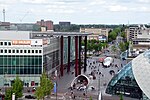Eindhoven Strijp-S railway station

Eindhoven Strijp-S is a railway station located in northwestern Eindhoven, Netherlands at the Strijp-S creative and residential district built on the former Philips factory complex. The station was opened on 23 September 1971 and is located on the Breda–Eindhoven railway. The station is operated by Nederlandse Spoorwegen. The station was known as Eindhoven Beukenlaan until 13 December 2015 when it was renamed Eindhoven Strijp-S. This is to reflect the redevelopment of the area around the station into a business park, called Strijp-S. Before 2018 the station will have lifts installed to make the platforms accessible for persons of reduced mobility, buggies etc.
Excerpt from the Wikipedia article Eindhoven Strijp-S railway station (License: CC BY-SA 3.0, Authors, Images).Eindhoven Strijp-S railway station
Achtseweg Zuid, Eindhoven Strijp
Geographical coordinates (GPS) Address Nearby Places Show on map
Geographical coordinates (GPS)
| Latitude | Longitude |
|---|---|
| N 51.450555555556 ° | E 5.4566666666667 ° |
Address
Spoor 3
Achtseweg Zuid
5617 AD Eindhoven, Strijp
North Brabant, Netherlands
Open on Google Maps








